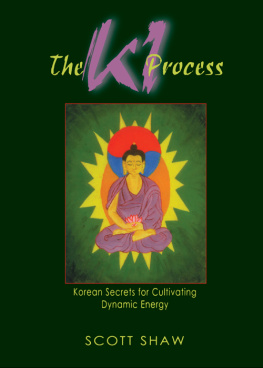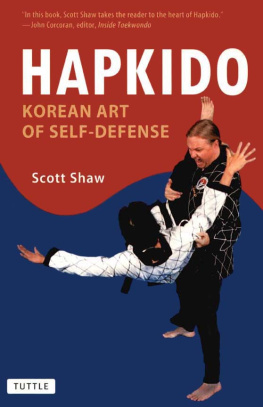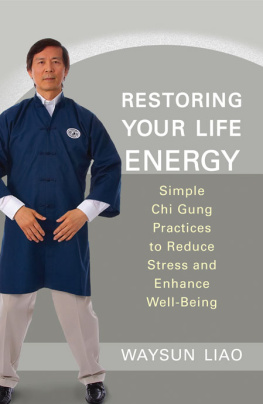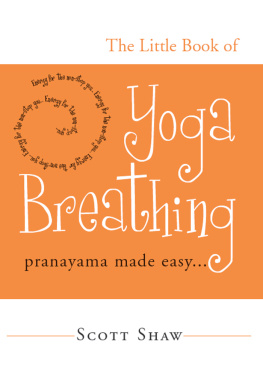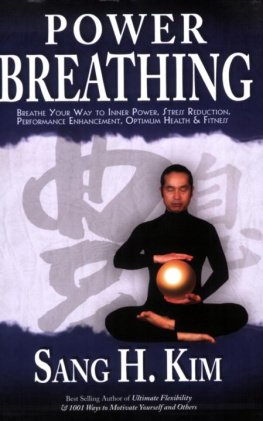
First published in 1997 by
Samuel Weiser, Inc.
BOX 612
York Beach, ME 03910-0612
Copyright Scott Shaw, 1997
All rights reserved No part of this publication may be reproduced or transmitted in any form or by any means, electronic or mechanical, including photocopying, recording, or by any information storage and retrieval system, without permlssion in writing from Samuel Weiser, Inc. Reviewers may quote brief passages.
Library of Congress Cataloging-in-Puhlication Data
Shaw, Scott.
The ki process : Korean secrets for cultivating dynamic energy / Scott Shaw
p. cm.
Includes index.
ISBN 0-87728-879-8 (alk. paper)
1. Ch'i (Chinese philosophy) 2. Mind and body--Korea. I. Title.
B127.C49548 1997
181.119--dc21
96-39551
CIP
MG
Typeset in 10.5 Berkeley Book
Cover and text design by Kathryn Sky-Peck
Cover painting copyright 1997 Hae Won Shin
Printed in the United States of America
03 02 01 00 99 98 97
10 9 8 7 6 5 4 3 2 1
The paper used in this publication meets the minimum requirements of the American National Standard for Permanence of Paper for Printed Library Materials Z39.481984
www.redwheelweiser.com
www.redwheelweiser.com/newsletter
TABLE OF CONTENTS
LIST OF ILLUSTRATIONS
LIST OF TABLES
ACKNOWLEDGMENT
Special thanks to Joan D. Albert, Ph.D., for her enlightened support throughout the creation of this book.
NOTE TO THE READER
The information provided in this book is not intended to replace the service of a physician. The material is presented for educational purposes and for self-help. The author and the publishers are in no way responsible for any medical claims regarding the material presented.
INTRODUCTION
T hrough modern science we learn that every element of this universe we inhabit is in motion, from the smallest subatomic particle to the largest planet. This motion is fueled by a constant, unceasing energy. Science has no defined name for it. In Asia, since ancient times, this energy has been known as Ki.
Ki is a universal energy. It flows through all things. Since Ki is present in all things, we, as participants in this energy, have the ability to tap into it consciously, through prescribed methods.
Ki is not the energy of an individual person; that is, personal strength. Ki can, however, be isolated and put to use by an individual.
Ki is not like a muscle which, through physical exercise, can be developed and strengthened. Development of your ability to utilize Ki comes through refining your mental clarity and your understanding of the way this universal energy intermingles with your body.
Ki cannot be harnessed. There is no savings account in the human body for Ki. Though Ki cannot be captured, it can be consciously received, focalized, and isolated, thereby bringing it into the realm of personal usage when the physical or mental need arises. From the science of thermodynamics, we learn that no energy in this universe can be created or destroyed; it can only be moved from one location to the next. This modern confirmation of ancient Ki understanding, confirms what the practitioners of Ki have proven for hundreds, of generations: that we can focalize and harness great amounts of energy, both physical and mental, and then use this energy to achieve current needs.
The undisciplined use of Ki can be illustrated ideally by the people who remarkably lift away a several-hundred pound boulder which has fallen on a loved one. Some way, somehow, these average individuals are able to harness superhuman power and save a person's life. Through the practice of defined Ki developmental exercises, you, too, can learn how to harness this energy, which is in abundant supply throughout the universe, and channel it into yourself to be used in times of need.
The development and understanding of Ki is not only a way to tap into superior physical power; it is a method to focus mental strength as well. By focalizing Ki through the techniques discussed in this book, you will have a much clearer perception of the world around youand how to substantially pinpoint your mental energies to achieve whatever mental task is at hand.
Ki was first described in the Huang Ti Nei Ching Su Wen (The Yellow Emperor's Classic of Internal Medicine). This text was created in China in the third century B.C. and was the first written document to describe how Ki energy enters, flows through, and then exits the human body. From China, this knowledge was passed on to the Korean peninsula in approximately 200 B.C. Once the principles of Ki had been absorbed into the Korean understanding of body and mind, the Hwa Rang (Flowering Youth) warriors of the Korean peninsula were the first to redefine Ki and use it as a way to enhance physical and mental power, thus making the science of Ki uniquely Korean.
Over the past several centuries, the practice of Ki has been utilized predominantly by acupuncturists, acupressurists, and martial artists. This does not mean, however, that the average person cannot utilize it as well. Modern society often times leaves the average individual in tremendous need of additional physical and mental energy. These early practitioners of Ki simply laid the groundwork for their ancient knowledge to be spread to the masses.
Ki is not an abstract science accessible only to holy men. It is a defined science that you, as an average individual, can put into use in your daily life from the first moment you begin to practice the very basic Ki developing exercises. In the pages that follow, I will discuss how Ki was understood and used from ancient Korea to modern times, and how you can put this science to use in everyday life to acquire better health and more physical and mental energy.
Part I

Introduction to the ki Concept
THE HISTORICAL FOUNDATIONS OF KI
I n order to begin your work with Ki energy, you must first possess a basic understanding of Asian medicine. This knowledge will greatly enhance your path to Ki mastery. While most people who read this book may already possess a knowledge of the terms which relate to Ki science, a brief overview follows for those of you who nlay not be familiar with the terminology. Even if you are familiar with this work, this section will introduce you to the terms I will be using in subsequent sections.
THE NEI CHING
The Huang Ti Nei Ching Su Wen (The Yellow Emperor's Classic of Internal Medicine), commonly referred to as the Nei Ching, was the first written text ever to discuss Ki (internal energy) and its interrelationship with the human body. In the Nci Ching, Ki is described as the universal energy which nourishes and sustains all life.
The Nei Ching is written in the form of a dialogue on the subject of healing between the Yellow Emperor, Huang-ti, and his minister, Chi-po. Huang-ti was a mythological ruler of China, whom legend claims to have lived from 2697 to 2599 B.C. He is said to have invented most aspects of Chinese culture. Though Chinese folklore claims the Nei Ching was written during the life of Huang-ti, historians date the book at approximately 300 B.c., during the Warring States period of Chinese history.
The Nei Ching not only describes Ki, but extensively details the functions of the human body. It represents an incredible accomplishment for this text to have been conceived and written by metaphysicians and medical practitioners of this time period, for along with a relatively correct detailed internal anatomy of the human body, the
Next page
